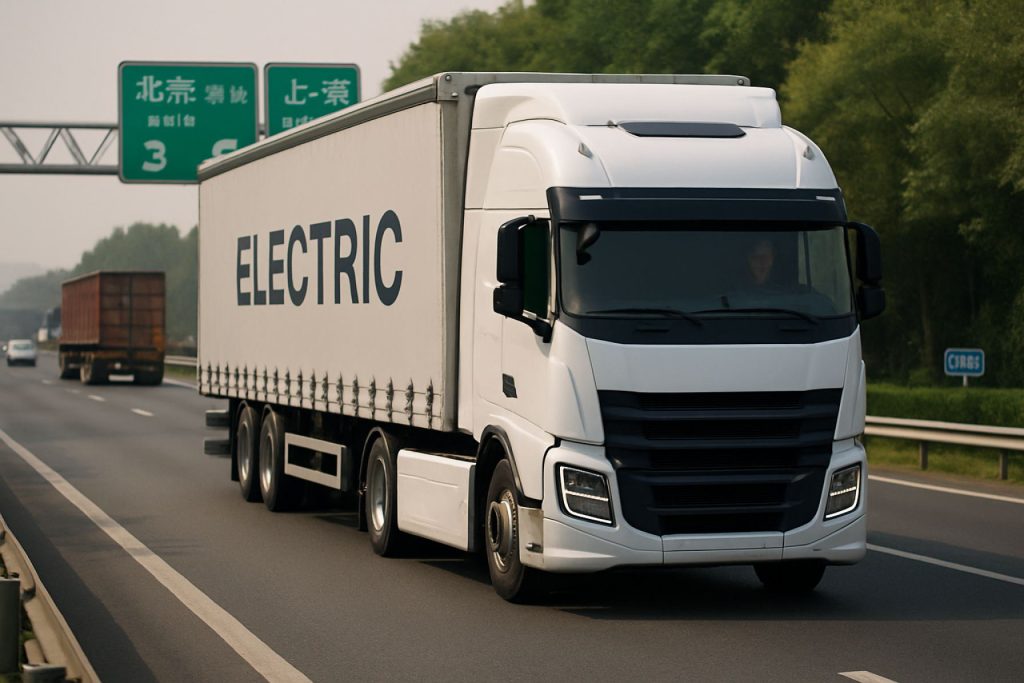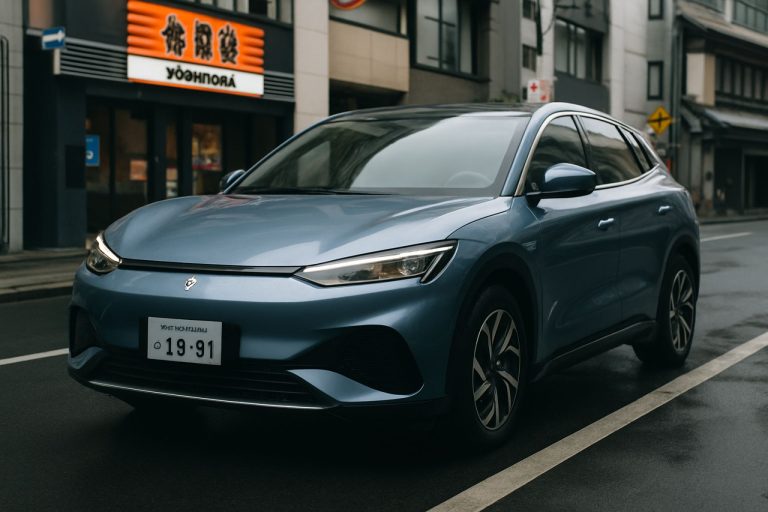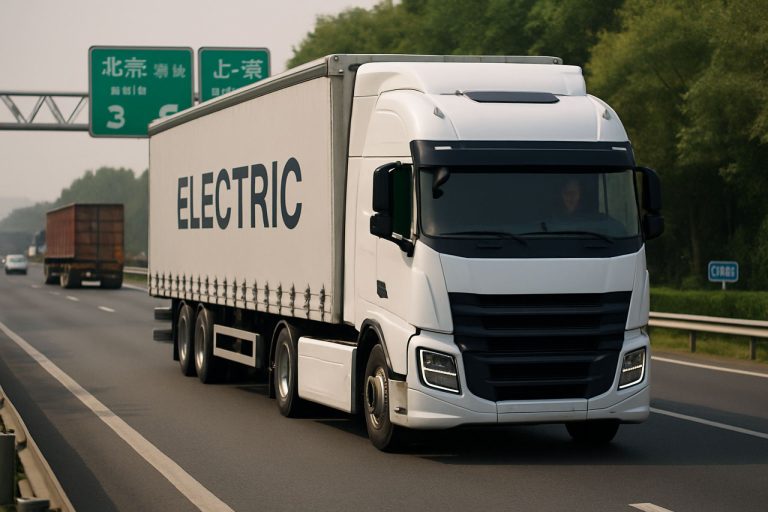
- China is rapidly electrifying its commercial trucking sector, with nearly 579,000 electric commercial vehicles added in one year.
- Electric trucks now represent over 20% of new commercial vehicle sales, marking a significant shift from diesel and gasoline vehicles.
- Heavy-duty trucks, though only 3% of total vehicles, contribute 43% of transport emissions—electrification offers major environmental benefits.
- Government support through subsidies, regulations, and charging infrastructure is accelerating fleet conversion and innovation.
- Fleet operators see reduced fuel and maintenance costs, along with increasing demand for sustainable logistics solutions.
- China’s shift in electric trucking influences global supply chains, energy demand, and the pace of clean transport adoption worldwide.
On the highways slicing across China’s sprawling landscapes, a quiet revolution gathers momentum—one that hums rather than rumbles. The unmistakable surge in electric passenger cars across the world’s largest auto market has already sent shockwaves through global industry. Now, that energy crackles through an unexpected conduit: the heavy commercial truck.
Last year alone, nearly 579,000 electric commercial vehicles rolled onto China’s roads, according to industry insiders—a milestone marked not just in numbers, but in ambition. Electrification among these workhorses topped 20%, almost doubling one year’s growth. Trucks, often perceived as stubborn holdouts for diesel and gasoline, now accelerate at the forefront of this green transformation.
The implications are as vast as China’s road network. Heavy-duty trucks, despite making up a scant 3% of all vehicles, are responsible for a whopping 43% of road transport emissions. In the calculus of environmental impact, every one of these vehicles that trades exhaust plumes for battery packs delivers outsized benefits. This sector also devours a lion’s share of oil—meaning that replacing diesel engines with electric motors could tilt the balance of global energy demand.
Government backing has helped lay the foundation: subsidies, favorable regulations, and a push for charging infrastructure have converged, spurring confidence among industry leaders. Homegrown giants and new players alike scramble to fortify supply chains and invent technologies that promise longer ranges and faster, safer charging.
Behind the wheel, logistics operators sense profit as well as responsibility. Lower fuel and maintenance costs tempt fleet owners to retire aging diesel engines. Meanwhile, mounting pressure from customers and communities alike puts sustainability at the center of strategic decisions.
China’s audacious pursuit mirrors the larger arc of global industry and energy. As battery costs fall and charging stations blossom along freight corridors, the old calculus shifts. What seemed improbable—electric drums pounding across continents, freight delivered with a whisper—now appears not just possible, but inevitable.
The world watches, and some worry. Will rapid adoption in China spawn new dependencies on critical minerals? How will global supply chains react if Europe and the United States lag behind? Many eyes turn to platforms like Bloomberg and CNBC for updates, but the pace on the ground exceeds even bold predictions.
One fact stands tall: the electrification of commercial trucks in China is not merely a local experiment. It is a reckoning—a glimpse into how technology, policy, and market forces can fuse to upend the status quo on a scale few imagined. As the world races to cut emissions, the thrum of these new engines signals more than a shift. It’s the overture to a cleaner, faster, and bolder age of transport.
China’s Electric Truck Revolution: Game-Changing Facts, Market Secrets, and The Global Race to Go Green
Unleashing the Silent Giant: China’s Commercial EV Truck Boom
China’s diesel truck-dominated highways are transforming—silently. While the electrification of passenger vehicles has grabbed global headlines, the surge of electric commercial trucks (including medium and heavy-duty models) across China is poised to shake the world’s logistics, energy, and automotive industries. Here’s what the numbers, technology, and market dynamics reveal—and what it really means for the rest of the globe.
—
Surprising Facts Not Fully Explored in Mainstream Coverage
1. China Dominates the Electric Truck Market by Volume and Innovation
– In 2023, China produced over 90% of the world’s new electric commercial vehicles, according to data from the China Association of Automobile Manufacturers (CAAM).
– Leading Chinese firms such as BYD, SAIC, and Foton are exporting electric trucks to developing nations, while probing markets in Europe and Latin America.
– The pace of adoption massively outstrips Western markets, where electric truck uptake remains below 2% overall.
2. Battery Technology: More Than Range Anxiety
– China’s truck batteries use a mix of Lithium Iron Phosphate (LFP) and Nickel Manganese Cobalt (NMC) chemistries.
– LFP batteries, favored for safety and lifecycle, are increasingly paired with sodium-ion batteries for city logistics, offering a more stable supply chain and avoiding cobalt/nickel price spikes. (Source: Contemporary Amperex Technology Co. (CATL) releases)
– Battery swapping technology is gaining traction: NIO and Geely have launched pilot stations where a depleted truck battery can be replaced in under five minutes—vital for logistics where uptime is money.
3. Policy Firepower Beyond Subsidies
– Regional pilot programs restrict new registrations of diesel trucks in city centers.
– Major hubs such as Shenzhen and Guangzhou set quotas for electrifying public and logistics fleets.
– Zero-emission zones (ZEZs) are being piloted at airports and ports, leading to mandatory electric truck use for certain deliveries.
4. Total Cost of Ownership (TCO): The Critical Metric for Fleets
– According to McKinsey & Company research, electric truck TCO in China reached parity or better vs. diesel for urban routes by late 2022, due to falling battery prices and low electricity rates.
– Some fleet owners see a 20-30% reduction in operating expenses over diesel, factoring in maintenance, repairs, and fuel.
5. Sustainability & Security Questions
– China supplies more than 75% of the world’s lithium-ion battery cells—raising concerns over supply chain vulnerabilities for other nations.
– Ministry of Industry and Information Technology (MIIT) mandates battery recycling standards, aiming for a minimum 60% material recovery rate by 2025.
—
Real-World Use Cases & Industry Trends
Use Cases
– Urban Delivery: JD.com, Alibaba, and SF Express operate thousands of electric trucks for last-mile delivery in major cities.
– Port Logistics: Electric trucks are standard for container transfers in ports like Shanghai and Ningbo.
– Construction & Mining: Several pilot projects employ heavy-duty electric dump trucks in coal and copper mines to reduce on-site emissions.
Trends & Forecasts
– Market Growth: Analysts at Wood Mackenzie forecast China’s electric truck sales to exceed 1 million units annually by 2026.
– Export Wave: Expect Chinese electric trucks to enter the Middle East, Africa, and Europe as regulations grow tougher elsewhere.
—
Reviews, Comparisons & Specs: China’s Leading Electric Trucks
– BYD T8
– Range: Up to 250 km per charge
– Charging: DC fast/full charge in under 2 hours
– Price: Approx. $90,000 USD
– SAIC Maxus EV80
– Payload: 1,390 kg
– Range: 200 km
– Popular for city logistics and municipal services
Comparison with Western Models: While U.S. competitors like the Tesla Semi promise 800+ km range, they aren’t yet mass-deployed. Chinese trucks focus on shorter, urban/intercity hauls with cheaper batteries—addressing the majority of freight needs, not just marketing headlines.
—
Pressing Questions Readers Have—Answered
Q: Will battery waste become a major issue?
– China leads globally in battery recycling infrastructure. Enforced policies ensure hazardous waste doesn’t pose environmental threats, and new plants for second-life battery applications are rising rapidly.
Q: Does electrification threaten jobs in traditional diesel engine manufacturing?
– Yes, but China is retraining workers for battery assembly, charging infrastructure, and EV maintenance. Government programs cushion the transition with reskilling initiatives.
Q: What about winter performance?
– Modern LFP and dual-chemistry batteries in Chinese trucks are optimized for cold weather, with thermal management systems—though range reductions up to 20% in extreme cold are reported (Source: CATL engineer interviews).
—
Controversies & Limitations
– Energy Source: China still relies on coal for a sizable portion of its electricity, diluting some environmental gains. However, new solar and wind capacity additions are among the world’s largest.
– Critical Mineral Dependency: Heavy reliance on imported lithium and rare earths presents future price and supply risks.
– Urban vs. Rural Divide: Infrastructure in remote or rural regions is far behind, slowing nationwide adoption.
—
How-To Steps and Quick Actionable Hacks for Fleet Managers
1. Run a TCO Analysis: Evaluate routes and uptime to see where electric trucks save over diesel.
2. Leverage Incentives: Check for regional subsidies and free/priority license quotas.
3. Invest in Smart Charging: Install depot chargers with scheduling for overnight energy savings.
4. Pilot Before Scaling: Start with electric trucks for local or fixed-route deliveries.
5. Monitor Battery Health: Use onboard telematics to maximize battery lifespan and schedule maintenance.
—
Actionable Recommendations for Truck Owners and Operators
– Stay updated via trusted global news sources like Bloomberg and CNBC.
– Form partnerships with established battery suppliers for tech support and warranty coverage.
– Use government EV procurement platforms to access discounted vehicles and infrastructure.
– Monitor upcoming zoning and emission regulations in your operating region.
—
Conclusion: The Roadmap to Global Leadership
China’s electric commercial truck juggernaut is no passing trend—it’s a purposeful, policy-driven leap toward industrial dominance and environmental leadership. As Europe and the U.S. race to catch up, expect market prices, technologies, and supply chains to rapidly evolve—reshaping not just how goods move, but who controls tomorrow’s logistics economy.
Key Quick Tip: If you’re in logistics or fleet management, start pilot projects with Chinese-made electric trucks now—before quotas tighten and early-mover advantages disappear.
—
For daily updates and deep dives into global electric vehicle trends, bookmark and follow Bloomberg or CNBC.
—
Keywords: electric trucks China, commercial EVs, fleet electrification, battery swapping, sustainability, global supply chain, new energy vehicles, green logistics, emissions reduction, market trends.



